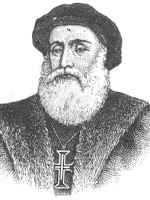Vasco da Gama
Vasco da Gama (1469?-1524) was a Portuguese navigator, was born in the small seaport of Sines in Alentejo. He was the first navigator to make the voyage to the East Indies by the Cape of Good Hope. In 1497 da Gama set sail with four ships from Lisbon and in November sailed around the Cape of Good Hope. Early in 1498 he reached the east coast of Africa and soon entered the harbor of Mozambique. His crew was in great danger because of the hostility of the inhabitants toward Christians. After leaving Mozambique da Gama touched at Mombasa and Malindi.
Holding his course straight across the Indian Ocean toward the Malabar Coast, da Gama arrived in 1498 at Kozhikode. In 1499 he set out on his return voyage and reached Lisbon the same year. On da Gama's arrival at the capital the king honored and rewarded him and his men. He had traveled 24,000 nautical miles and was the first European to reach India by sea. Da Gama was named admiral of the Indies and given the title of dom, with an annual pension and extensive commercial privileges.
In 1502 da Gama was placed at the head of a powerful fleet. He provided for the security of future voyages by founding colonies at Mozambique and Sofala.
After he had lived many years in retirement, da Gama, in 1524, was appointed viceroy of India by King John III. He left the harbor of Lisbon with 14 vessels. He visited several small colonies and used all means in his power for their defense and the preservation of the authority of the Portuguese arms among the natives. He had administered his office for scarcely three months when he died at Cochin, in India. Da Gama's first voyage was the subject of Camoens' epic Lusiads.
